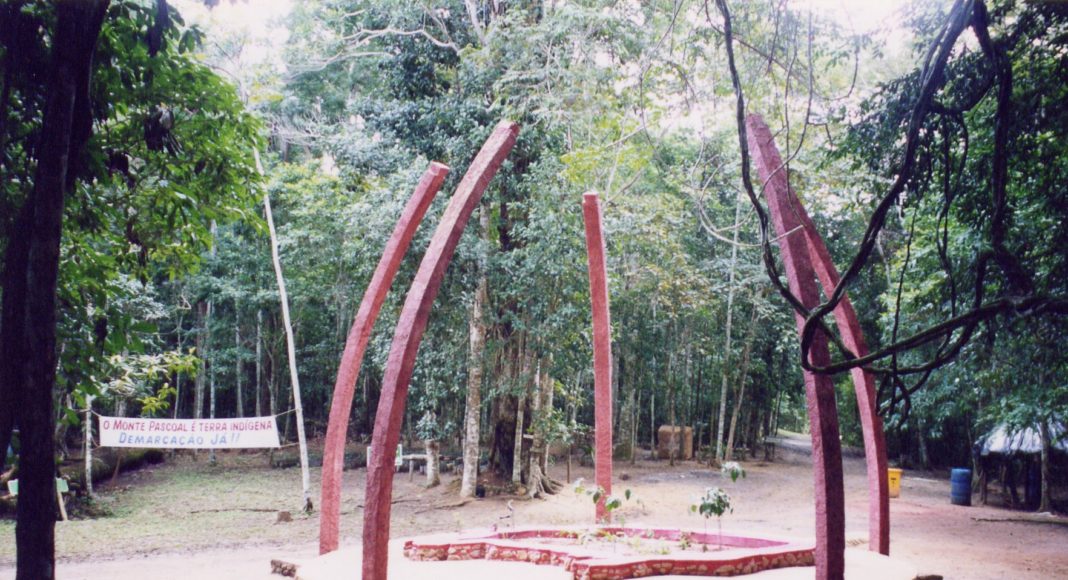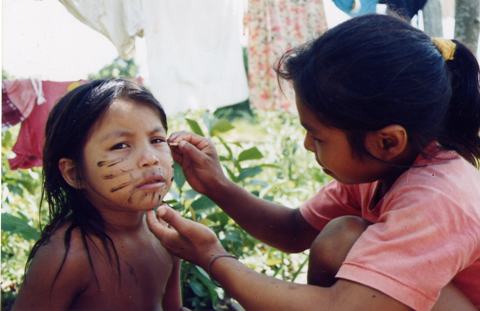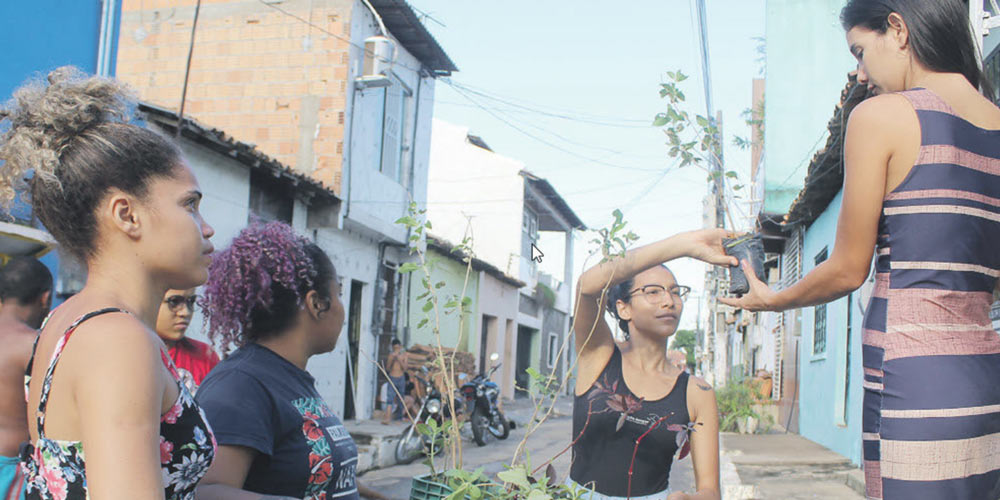Dan Baron Cohen and Manoela Souza first collaborated with the Pataxó People in Coroa Vermelha, Porto Seguro, South-East Bahia, in 2000, to build a monument to the ‘Other 500 Years’, to question the celebration of the ‘Discovery of Brazil’, by the then Brazilian government led by Fernando Cardoso Henrique.
The monument in construction by Pataxó women and children was destroyed by 200 armed Military Police on 20 April, 2000, making front page news throughout Brazil and Latin America.
In 2001, the cultural activists returned to complete the process, this time building a more ‘resistant monument’ entitled ‘500 Years of Resistance by the Indigenous Peoples of Brazil’, in a clearing on Monte Pascoal (Easter Mountain), land first sited by the Portuguese captain, Pedro Alves Cabral, before landing on Coroa Vermelha beach, on 22 April 1500, to colonize Brazil. It was inaugurated on 19 August, 2001.
In November, 2019, an unexpected phone-call begins a new dialogue.
Ahnã petoī akuã, anhã petoī sarä dxahà txobiharê
‘I have my bow, I have my arrow, I have my root to cure’ — Pataxó song
On my phone, I click on the unknown caller.
Ikhã: Sir, I am Ikhã Pataxó, from Easter Mountain. I’m married to the son of Chief Braga, from Foot of the Mountain village, Bahia.
I glance at Manoela, and up at the carved ornamental spear hanging on our wall that Braga carved from Ipê wood nearly 20 years ago to create his gift to celebrate our friendship and the launch of the monument. The unexpected mention of Braga’s name makes us smile. I hear his easy laughter as he improvises his narrative song of our emerging process, echoing through the forest.
Ikhã: I’m finishing my undergraduate thesis, analyzing the sociocultural impacts of the collective process of the construction of the monument, 500 Years of Resistance by the Indigenous Peoples of Brazil. Would Sir answer some written questions about the key moments, how you worked, the meaning of the symbol?
Dan: Please call me Dan, Ikhã. I don’t know this ‘sir’.
Ikhã: Dan. Sorry, I’m not used to calling my seniors by their first name.
Dan: Let me present Manoela. She mediated our collaboration.
The two women greet each other with smiles.
Ikhã: Dan, would you grant me an interview?
The request from a Pataxó student reassures us. President Bolsonaro has promised to ‘liberate’ all indigenous territories for commercial mining, so his ‘Indians’ can fulfill their democratic right to ‘become human’ in the cities of Brazil.
Dan: How is the monument, Ikhã?
As I wait for her answer to appear, news of the murder of Paulinho Guajajara, a young indigenous leader, as he defended Guajajara land, flashes and disappears on the screen in the palm of my hand. I look across the Tocantins River at the shimmering blur of red that is spreading along the horizon. No-one here can even name their indigenous people, let alone see the burning forest as their ancestral home on fire.
Ikhã: One of the five bows that protect the medicinal garden has been broken.
Manoela’s and my eyes meet.
Dan: Political vandalism?
Ikhã: No. A tall Ipê tree fell across the monument.
Dan: Can you send us a photo of the damage, Ikhã?
500 years of memory, 500 years of resistance
Images from 20 years ago flash across my mind. The torê danced throughout the night to the beat of the maracá, to summon the storm which filled four huge containers with enough water to make the cement bows. Precious stones, placed one by one in molten cement as it was poured into the curved metal structures, transforming the bows into sacred guardians of 500 years of memory. And Marlene, pregnant with her seventeenth child, wielding a huge hammer to break stones for the monument’s base, defying the custom that prohibited women from ‘being’ in public.
Ikhã: You don’t know me, Dan, Manoela. I was a three year old, one of hundreds of children, teenagers and adults that you consulted to imagine the monument. My family carried stones from our village to the clearing in the forest, to build its circular base. Just a few days ago, Chief Braga showed me my photo in your book, being painted on ‘Day of the Indian’.
I smile at Manoela. We instantly recall the photo, a girl painting her younger sister’s face, then both running to enter the torê, a human river of Pataxó culture, weaving its way through the moon-lit forest, scores of right feet synchronized in song: “Step, step, step, step slowly, I will step slowly on the leaf of Jurema.”
Ikhã: We need to restore that bow, Dan. We need that monument to inspire our people to stand firm. We’re being seduced again by the white man to leave our ancestral lands to become citizens in Porto Seguro.
Dan: Do you know the story of those bows, Ikhã?
Ikhã: I know you all stopped wearing flip-flops when you entered the space they protect, to respect our seven million murdered parents, present beneath it.
Dan: But did anyone tell you, Ikhã, how we made present the invisible 40 million murdered indigenous people of Latin America?
Ikhã is replying. As I wait, Manoela and I study a photo of Paulino Guajajara’s painted face which appears on my screen.
Manoela: His gaze inspires courage, determination.
Ikhã: I only know that those bows protect a circle of healing. That whoever enters it is cured. Becomes brave. A leader. And that in the years that followed, we recovered our Pataxó language, built Pataxó schools, chose women to become our chiefs.
I look at Ikhã’s status photo, creating her self-portrait on her cell-phone, in front of a mirror. Always, that mirror of seduction.
Dan: We all had to be brave, Ikhã, to open the path as we created our method, with no map, compass or river to guide us. When the five bows were erected, we all looked at the completed monument, to rest and admire the living sculpture we had created. Suddenly one of the elders spoke out: “Dan, you are leading this movement. Why do the bows have no strings? When people visit tomorrow and In the future, they will say, this is a monument of defeat. Of despair. The bows have no strings because the resistance has been defeated.”
I glance at Manoela. She too is back in the forest. I pause to give Ikhã time to digest the narrative, to ask any question. I sense her in her village, listening, waiting.
Dan: I looked at all the people who were working there in that clearing that day. Mano and I could feel the elder was speaking for them all. We knew our place and our roles. To listen. To support. But we felt their expectation. That we would be truthful and speak from within our own ancestral heart. I asked Joel, our host, a wise Chief, to mediate my words.
“We have created this symbol together, from your stories and dreams. There is no leader.”
- I paused. Chief Joel translated. I continued.
“But I have a question. Should we place rope in each bow, each symbolizing a century of resistance, so that everyone reads a bow? Or is it better to leave the bows as they are, so that when visitors look, they whisper to each other and to themselves. Are these bows? Then why are there no strings? They could be a red crown, the crown of Portugal, now protecting an indigenous garden. Or a flower, celebrating the beauty and resilience of the forest. Should each person have the freedom to see and choose?”
- No-one seemed convinced, Ikhã. Did they even understand? So Chief Joel said: “Consult your families, listen to each person, and let’s take our time to decide.” Everyone left in thought and I wondered if I’d made a good proposal. Days passed slowly, the forest echoing with whispered debate, generations of Pataxó sitting on their haunches, pointing at the bows, nodding, smoking, exchanging few words. Joel listened without a murmur. Braga sang all he heard, faithfully, and the forest echoed.
- We returned a week later, Braga (walking with my video camera in affectionate parody of the international director at his side), Chief Joel, Manoela and I. We studied the silent, expectant forest of eyes. Chief Joel finally stood and took one light step forward.
“Look at our arched bows.” We all turned to look. “Do you see their strings?” The bows were clearly bent in tension. “The strings are there, and they are not there”. He paused. “Do we not have a Pataxó proverb? We warriors never reveal the secrets of our resistance. Our bows are strung. Ready. But we do not need to reveal that. Let people interpret as they wish. If they feel safe, inside a crown or inspired by a flower, they will join us. We know our bows are always prepared. Our bows are brave. They are strung. That’s enough”. We all smiled.
I pause. Ikhã is there. Invisible but present.
Turned into giants
Dan: With that poetic insight, Ikhã, Chief Joel united his people. And he’d revealed the relation between the fist of resistance and the open palm of liberation.
Ikhã does not respond.
Dan: Mano, have we lost our connection? Did I tire her?
Manoela points at the second tick to show Ikhã has received my words. It turns blue. I turn on the audio-recorder.
Dan: Was I clear?
Audio immediately returns.
Ikhã: Now I understand the pedagogy of bravery. Why that monument turned us all, even the maimed, the lame and the weak, into giants. Thank you.
I smile at Manoela. Who would have imagined a three year old girl in a torê of 2000 Pataxó preserving and reinventing an epic narrative, was being formed, becoming the pulse of a new generation?
Dan: We will return to help repair that bow, Ikhã, so the monument protects other new seeds in the garden.
Ikhã: I’ll speak to the Pataxó youth, Dan, Manoela. Now I must return to my children. Good night.
Dan: Good night, Ikhã. Thanks for calling.
This article is an extract from ‘Brave Trialogues of Unlearning’, Baron Cohen, D., Souza, M. & Vaudrin-Charette, J. (in press), in Macdonald, J. and Markides, J. (eds), Brave Work in Indigenous Education, Community Wisdom Series, New York, DIO Press.




